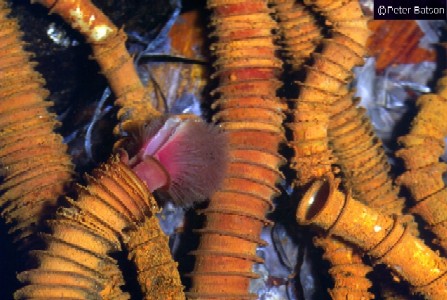Life on the Dark Side: Chemosynthetic Ecosystems
Dr Steffen Kiel of University of Leeds gave a presentation entitled Life on the Dark Side: Chemosynthetic Ecosystems. These are ecosystems which rely on geochemical energy as a food source, rather than photosynthesis. They are found about the geothermal vents associated with oceanic ridges, hydrocarbon ‘seeps’ at lower temperatures and linked with sunken whale carcasses and drift wood. He had a selection of amazing video clips of these assemblages including a tube worm with its tail anchored in a vent at 80oC and its feeding end only a few cm away in water at 20oC.
He revealed a dead whale to be a fascinating thing. Upon death and sinking to the sea floor, scavengers take up to two years to strip the carcass of meat. Crustaceans get a further two years sustenance until the bones are truly stripped. Then bacteria get going and utilise the natural oils, which make up 50-60% of whale bones, for up to 100 years. Wood-falls also have a unique ecosystem.

A key question Dr Kiel is concerned with is did these animals migrate to the extreme environments of the geothermal vents and seeps using the whales and drift wood as ‘stepping stones’.
Working with Oligocene and Miocene sediments in the subduction zone to the north west of the USA he has traced the evolution of the wood-fall and whale-corpse assemblages. Oligocene wood-fall assemblage dated at 35Ma are remarkably similar to modern examples.
However Oligocene whale corpse assemblages resemble wood-fall assemblages of the same age, but in the Miocene the whale-corpse assemblages differ from Miocene wood-fall assemblages and begin to resemble modern whale-corpse assemblages.
Dr Kiel ties this in with the evolution of whales, changes in their bone-oil content and patterns of distribution in the oceans.
Turning to the key question, if the whale corpses were stepping stones to populating the vents, the first occurrence of vent species should coincide with the Miocene whale radiation. A detailed statistical analysis of mollusc species, plotting when they first appeared in the geological record, has failed to prove the ‘stepping stone hypothesis’ but the data is equivocal. The alternative view of the question ‘did life first evolve at these vent locations’ also remains unanswered.
Niall Clarke
**************************************

